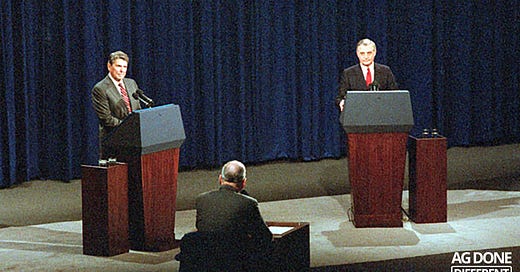How to Regain Influence in a Market That’s Already Made Up Its Mind
The strategic advantage of framing, not persuasion—why the future belongs to those bold enough to break the frame.
The single greatest context shift anyone has ever pulled off in American politics happened in Kansas City, Missouri, on October 21st, 1984.
That night, Walter Mondale and Ronald Reagan met for the final presidential debate before the election. Everything was on the line. Reagan had stumbled in the first debate. He looked old; he sounded tired.
For the first time, voters began to wonder whether the presidency had passed him by. Whether the man who had once exuded confidence and clarity was now too slow, too frail, too far past his prime to lead for four more years.
Commentators pounced, and the polls tightened. Reagan's age, once a quiet undercurrent, became the central question of the race. At 73, he was the oldest president in American history.
Was he still sharp enough to lead?
Heading into Kansas City, Reagan’s advisors told him he needed to address the problem head-on. He needed to convince the American people that he still had what it took to lead. They wanted to script talking points and test poll answers to gauge public opinion. The president simply told them, “I’ve got it.”
The lights came up. The questions started. And then, just twenty minutes in, it happened.
Henry Trewhitt of the Baltimore Sun asked Reagan directly whether age would affect his ability to serve. It was the moment his critics had been waiting for…a chance to watch him falter again. To see if the weight of 73 years would finally show.
Instead, Reagan smiled.
“Not at all, Mr. Trewhitt,” he said. “And I want you to know that I will not make age an issue of this campaign. I am not going to exploit, for political purposes, my opponent’s youth and inexperience.”
The room erupted in laughter. Even Mondale joined in. The entire issue vanished with a single line.
Two weeks later, Reagan won 49 of the 50 states. Only Mondale’s home state of Minnesota remained blue.
In the world of agricultural marketing, we spend an incredible amount of time trying to change people’s minds, trying to get them to “think different.”
We try to figure out how to position our new seed genetics so they don’t just sound like more of the same. We struggle to explain the value of our innovative agtech when it passes under scrutiny. We tweak messaging for crop protection products, hoping someone notices that this formulation really is different. And ag retailers push to be seen as trusted advisors, not just the place that sells inputs a few cents cheaper.
The problem quickly becomes clear. We’re trying to change minds in a market that’s already made up its mind.
So we double down. We add more proof points. More data. More testimonials. We build another deck. Launch another campaign. Train the sales team to "tell the story" better.
Keep reading with a 7-day free trial
Subscribe to Ag Done Different to keep reading this post and get 7 days of free access to the full post archives.





